We make a steep descent into Paro airport, considered the most hazardous airport in the world, due to an extremely short runway and thickly forested mountains all around. Here’s a video of our descent.
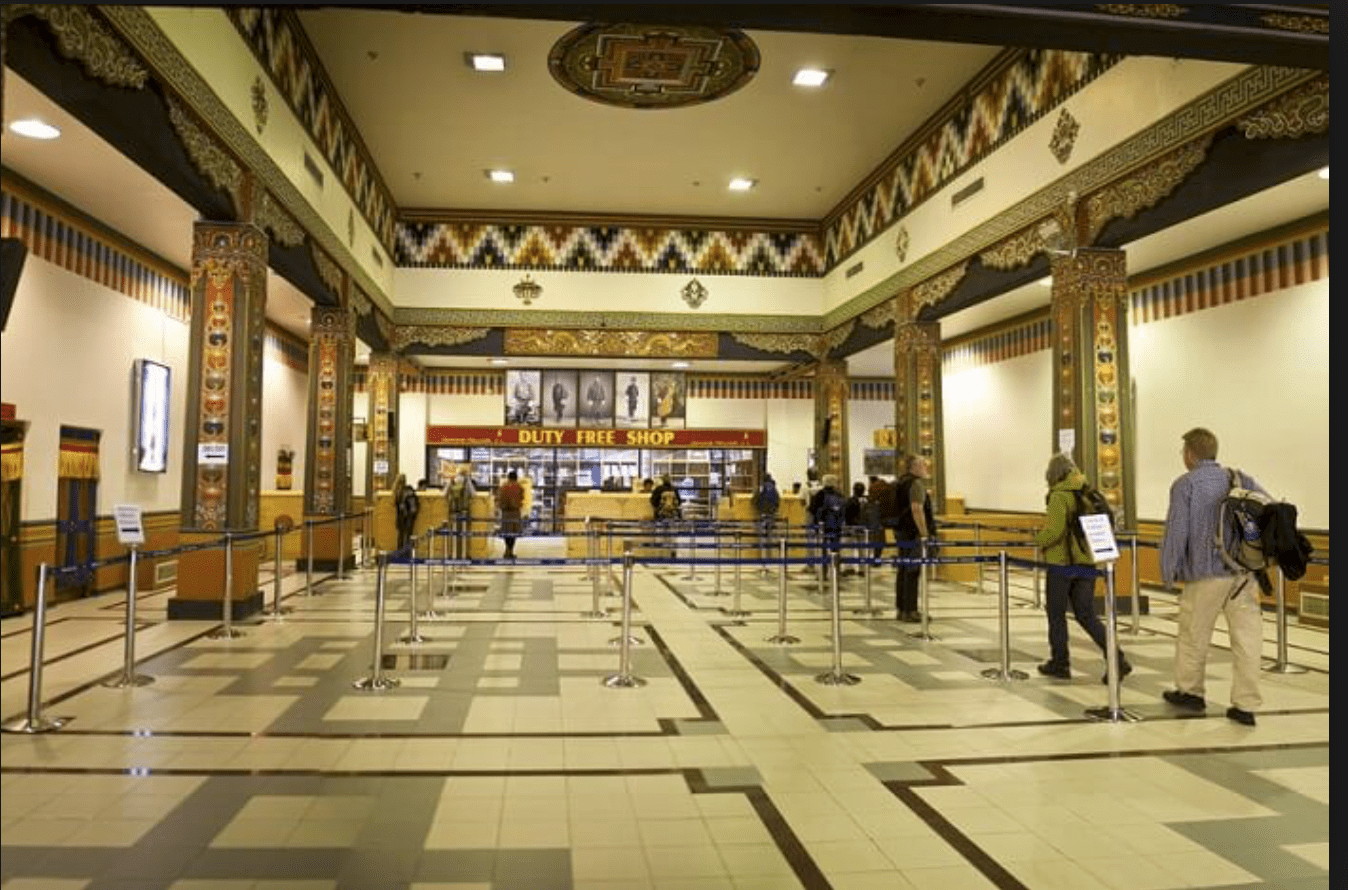
Paro Airport
Inside, Paro airport is impeccably clean with high ceilings, hand-painted columns and walls. Calm, healthy men and women in traditional clothes complete the tranquil scene. In Bhutan, professional workers wear the national dress – that means a Gho with cuffs for men, and a Kira wrap with silk jacket for women. Notice the five kings pictured above? In comparison to Nepal’s chaotic airport, this is a different universe.
After an officer checks my passport, I walk out of the airport into a crisp sunny day. The air is clear, full of oxygen, and the sky deep blue with a few billowing white clouds. Where’s my Lama? Just then a red car drives up full of excited squealing women and children. They pour out of the car to greet me with a ceremonial khata. I meet three of his sisters and two young daughters. Lama’s best friend Tinzen arrives a few minutes late because he had to wash his car, a spotless SUV with handwoven Tibetan carpets. They’re all wearing their national dress out of respect. Lama is quiet and looks very handsome in his Gho.
Ceremonial snacks by the river
We pile into two cars and stop at a gushing riverside, where they lay yak hides on the ground and serve a snack. We share butter tea with crispy rice in it, yellow saffron rice, roasted corn, and sweet fermented rice porridge. The little girls give their dolls a foot bath in the river. Lama is quiet and smiling. I was worried about being embarrassed with all this special treatment, however I notice feel at ease. Their warm welcome is an expression of love for their brother. They ask me if I like the food, and in the expectant silence, I get to recite my one sentence in Dzongkha: ”Che khaara, name same lezhem do. Nga sem gayi”, which means “You are all very kind. I am so happy.” They giggle and say my pronunciation is good.
We pile back into two cars and head for Lama’s sister’s home an hour away in Thimphu. We bring my suitcases upstairs, and present everyone with the gifts we’ve been assembling. Skecher shoes, Crocs, silk fabric, hats, and ceremonial silver puja bowls. I hand out the presents, play with the children, and explore the house, a 2-bedroom apartment on the 3rdfloor of a traditional Bhutanese building, spotlessly clean and simple.
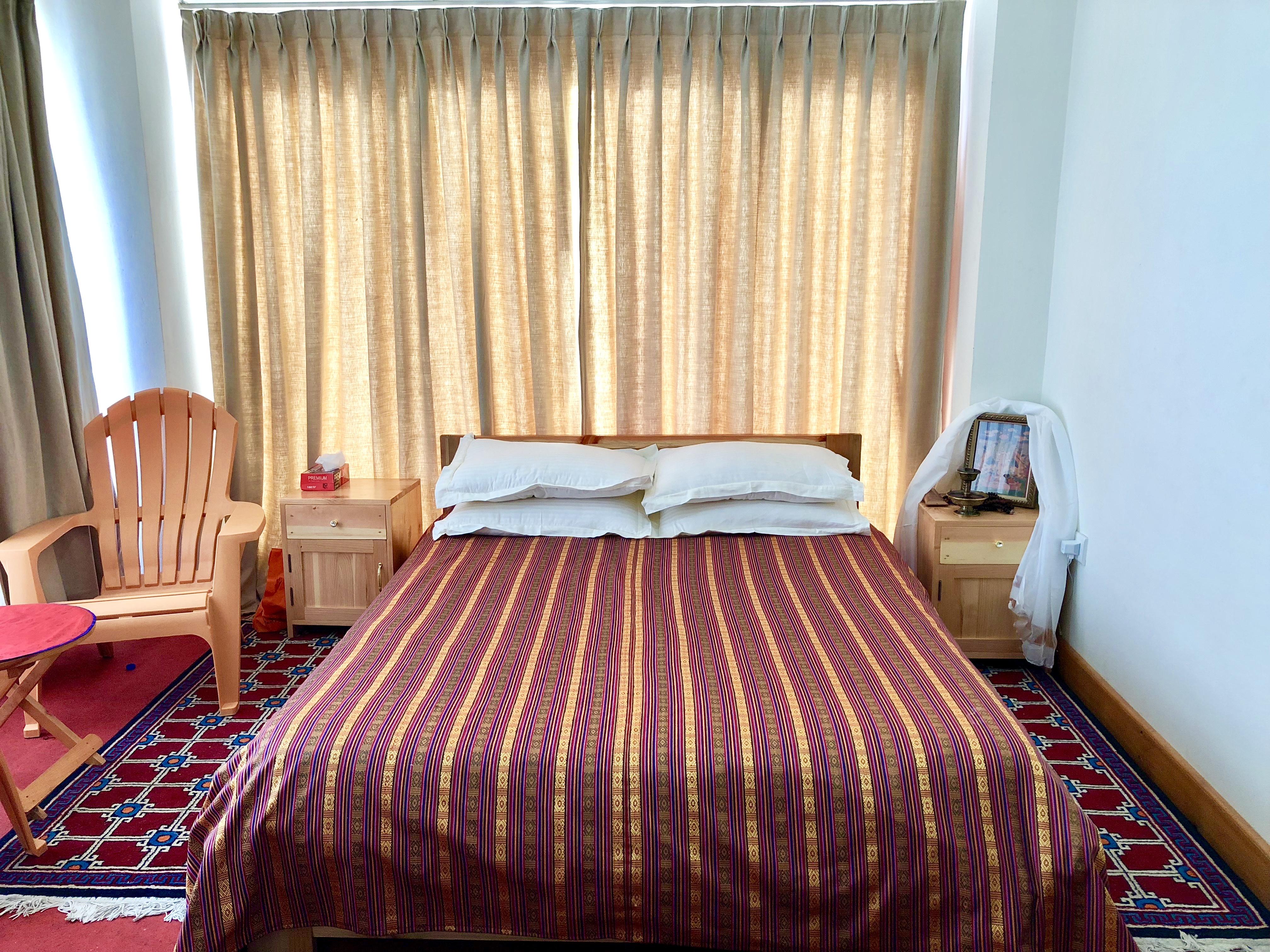
Matrimonial suite (after smoke cleared)
We drive to Tinzen’s house where Lama and I will be staying. It’s 15 minutes outside of Thimphu up the mountain in a small complex of condominiums in the forest. We arrive and Tinzen opens the door. The whole house is filled with smoke. Everybody invites me into a bedroom. It is so full of smoke from blessings and pujas that I can hardly see or breathe. The matrimonial bed is beautifully draped with a traditional handwoven ceremonial Bhutanese fabric. They surround the bed with joy, and through thick smoke, they ask me excitedly how is the room? Do you like it? I get it. I lay down and try the bed. Oh, so comfortable! Yes, this room is very beautiful! Thank you. I love it! They respond with satisfied smiles and pile out of the room.
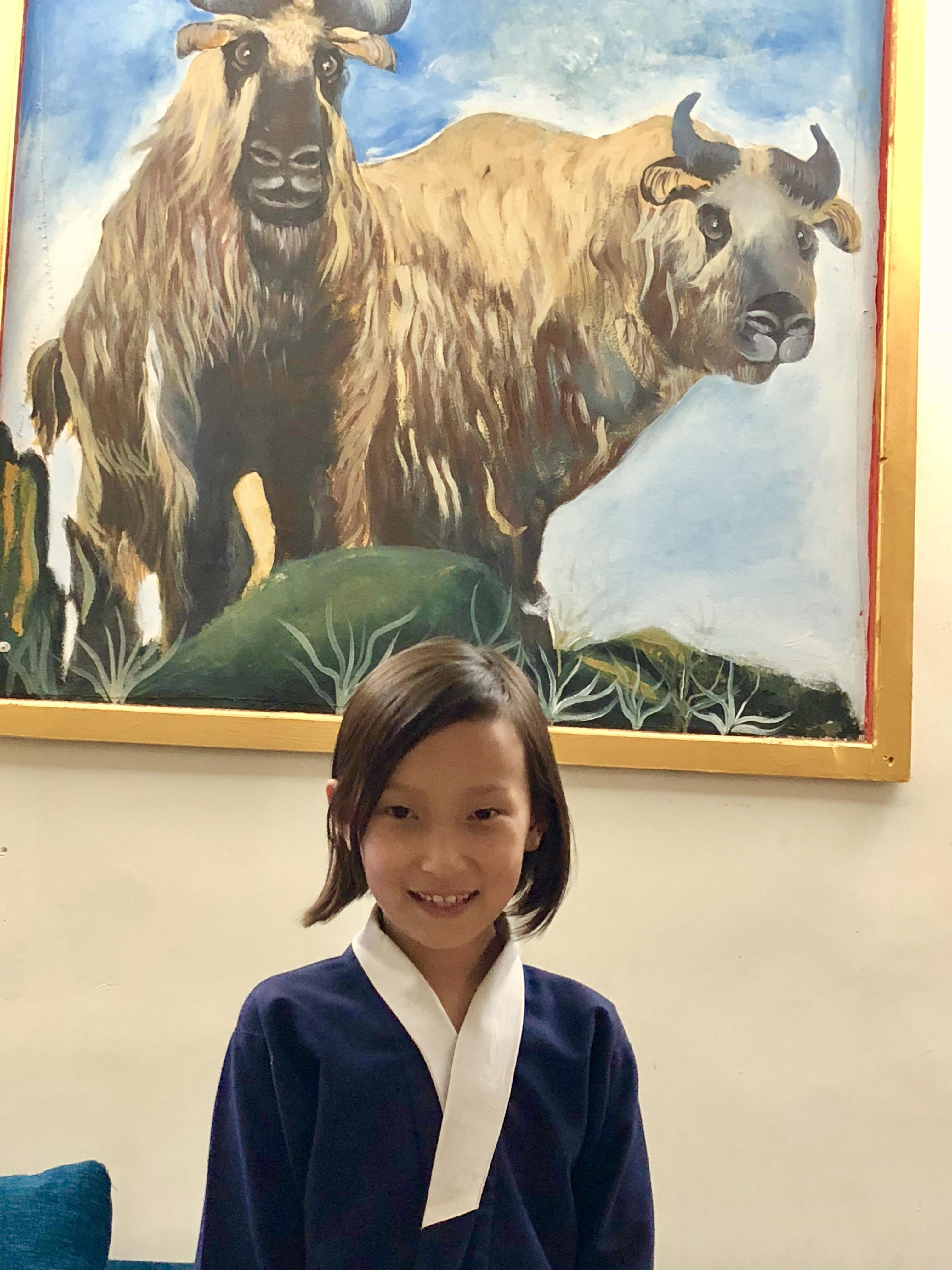
This is Ghalem’s daughter, Kayzang, which means “happy gathering”. She was born in New York, holds an American passport, and is still wearing her school uniform. The children call me “Auntie Jane”. They speak excellent English but are too shy to try it. Finally I join them in a game of hide and seek and we connect easily.
Dinner is being prepared. I’m instructed to sit and relax on a large couch in the living room. My luggage comes upstairs amid joyful talking and laughing. Everyone is speaking Dzongkha, and I don’t understand a word. From time to time Lama or his two sisters tell me what’s going on. Dinner is white rice, yak cheese with peppers, really hot red peppers, and warm yak cheese. Delicious! I am given utensils and they eat with their hands. I start to get up to take my dish into the kitchen, and the Lama says “Don’t move. Leave it there. You are an honored guest. They want you receive this celebration.”

Everyone is talking in the living room and watching news of the elections on TV. Lama says this can go on for hours and I am free to go rest. “We all love each other so much, we always want to be together.” Yep, it went on for hours. Finally everyone gets up and says good night. Lama tells me “Good job. They like you. You made a good choice in clothing to wear. Tasteful with maximum covering of the body.”
I discover later that intense preparations have been going on for days, and the whole family helped get our room ready. They even created a “Jane” group on social networking to organize the work. They all chat together daily on their iPhones. Tinzen gave up his room so Lama and I can have the master suite with bathroom. He furnished the house, hired Indian workers to install curtains all over the house, spared no expense to buy the best mattress, cotton sheets, pillows, matching terrycloth robes, and a wooden armoire to hang my clothes. I am served breakfast, lunch and dinner. So far I’m not allowed to do anything to help. I protest. Today Tinzen said maybe tomorrow I can help cook.
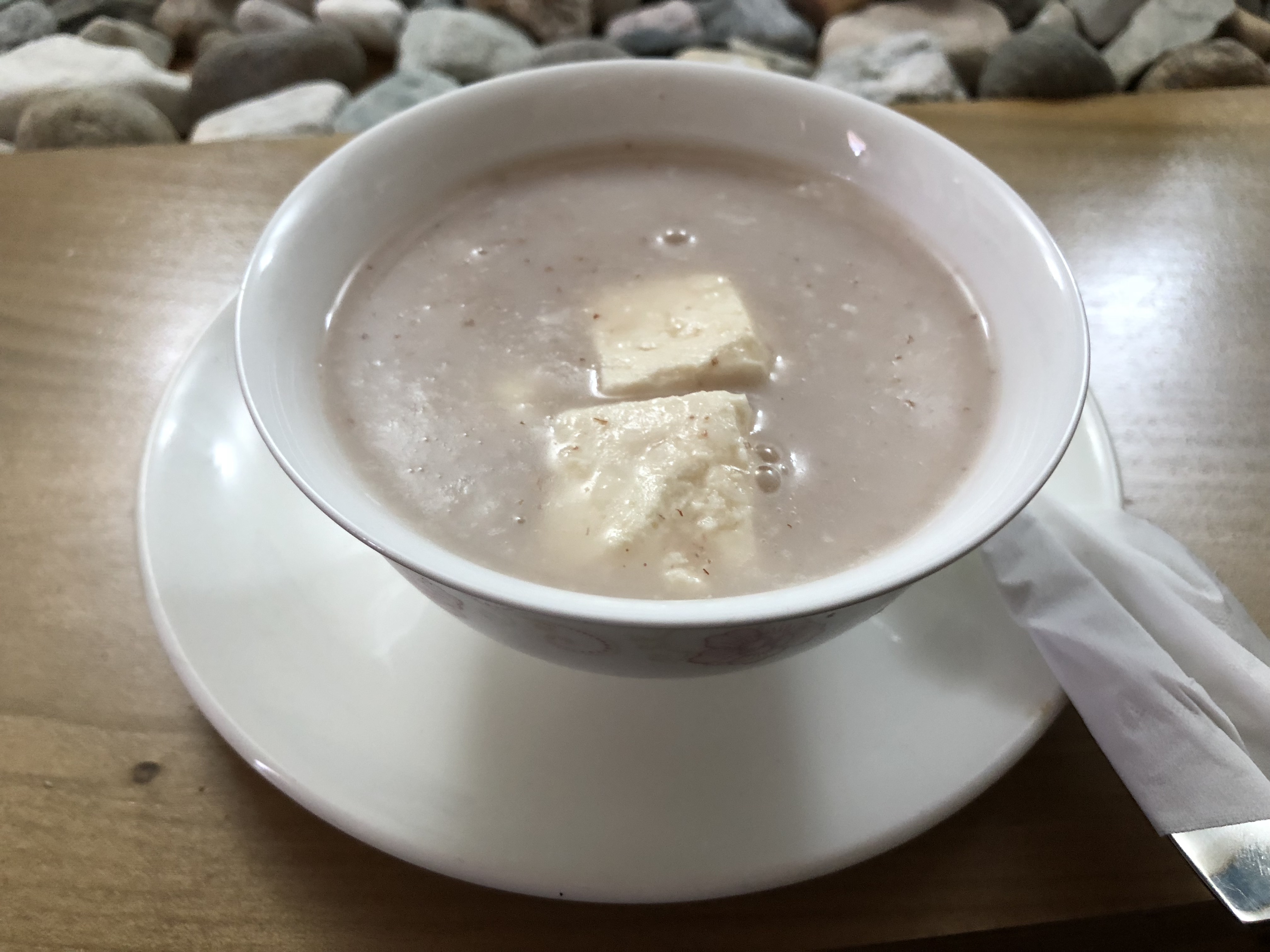
My first Bhutanese breakfast is a creamy hot red rice porridge with two squares of soft yak cheese. Yummy!
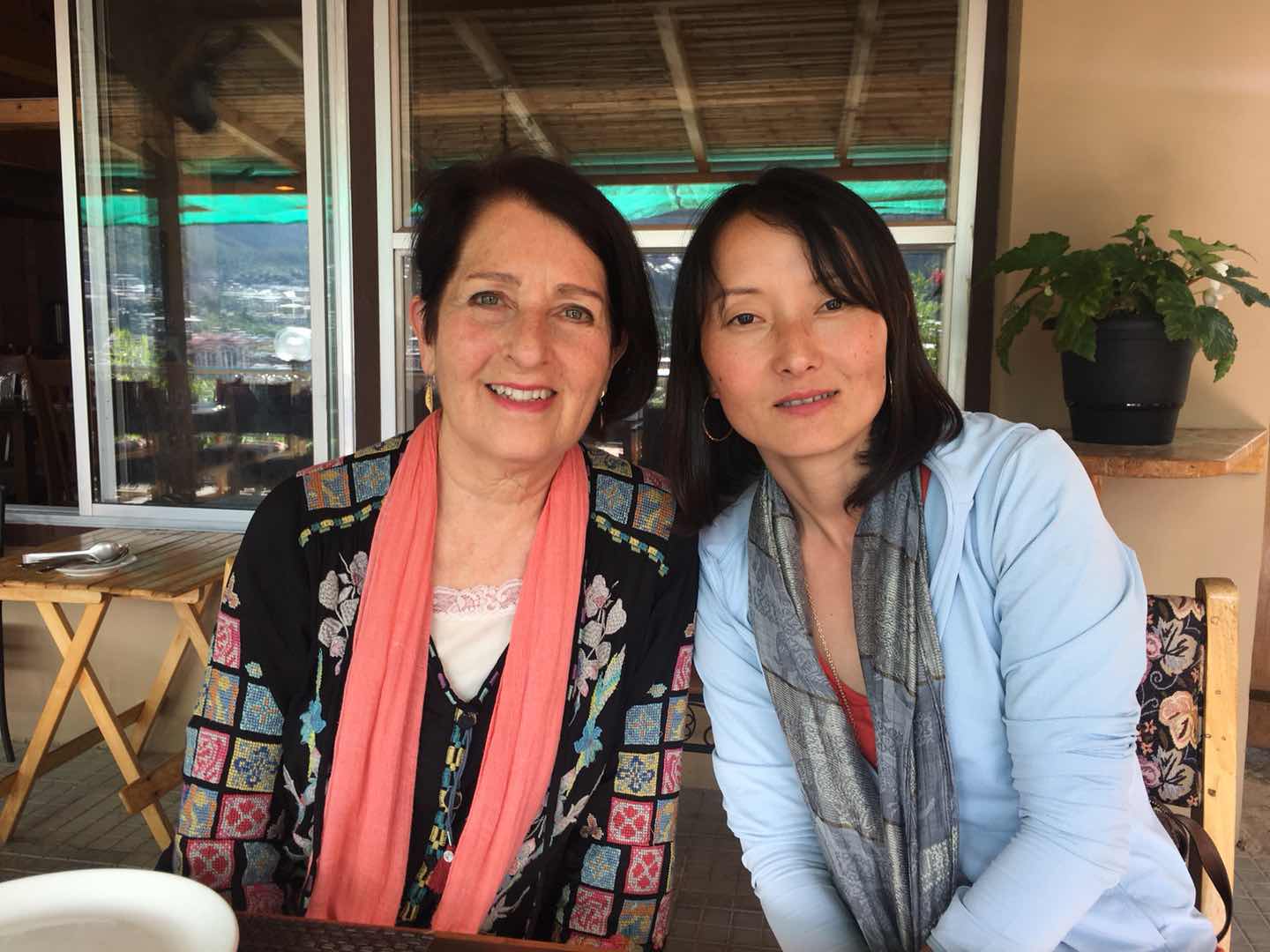
This is Lama’s sister Ghalem, one of the brilliant strategists responsible for my visa. I am here in Bhutan as her personal guest. Ghalem lived in New York for 5 years, so she’s familiar with the culture and speaks flawless American English.

Buddha point is a breathtaking golden statue high up on the mountain overlooking Thimphu, the capital of Bhutan. The largest statue of the Buddha in the world, this powerful image is surrounded by an expansive open area and an itinerary of hundreds of golden goddesses, each holding a special symbol in her left hand. I found it very moving. Even more impressive is the lack of trash, food stalls, trinkets, and beggars that surround most tourist attractions. I commented on this, and Tinzen replies: “This is Bhutan. We are clean and respectful.” Buddha Point was created just a few years ago, offered by a generous individual from Singapore.
Lama and I got up early this morning in Thimphu. Tinzen’s place is in the forest, which reminds me of the Minnesota woods where I grew up. A few hundred years ago much of the USA and Canada were covered with forests like this. Lama is pleased with my Dzongkha – it’s improving every day. This phrase means “Good morning. Bhutan is a very nice country. Thank you.”

This is Tinzen, Lama’s best friend. He is a painter of Buddhist iconographic art and thankhas, and he’s very well known in Bhutan. Tinzen treated us to a 5-day tour of his favorite monasteries in Bhumthang and Phobjikha Valley. He is creative, kind, and overly generous.
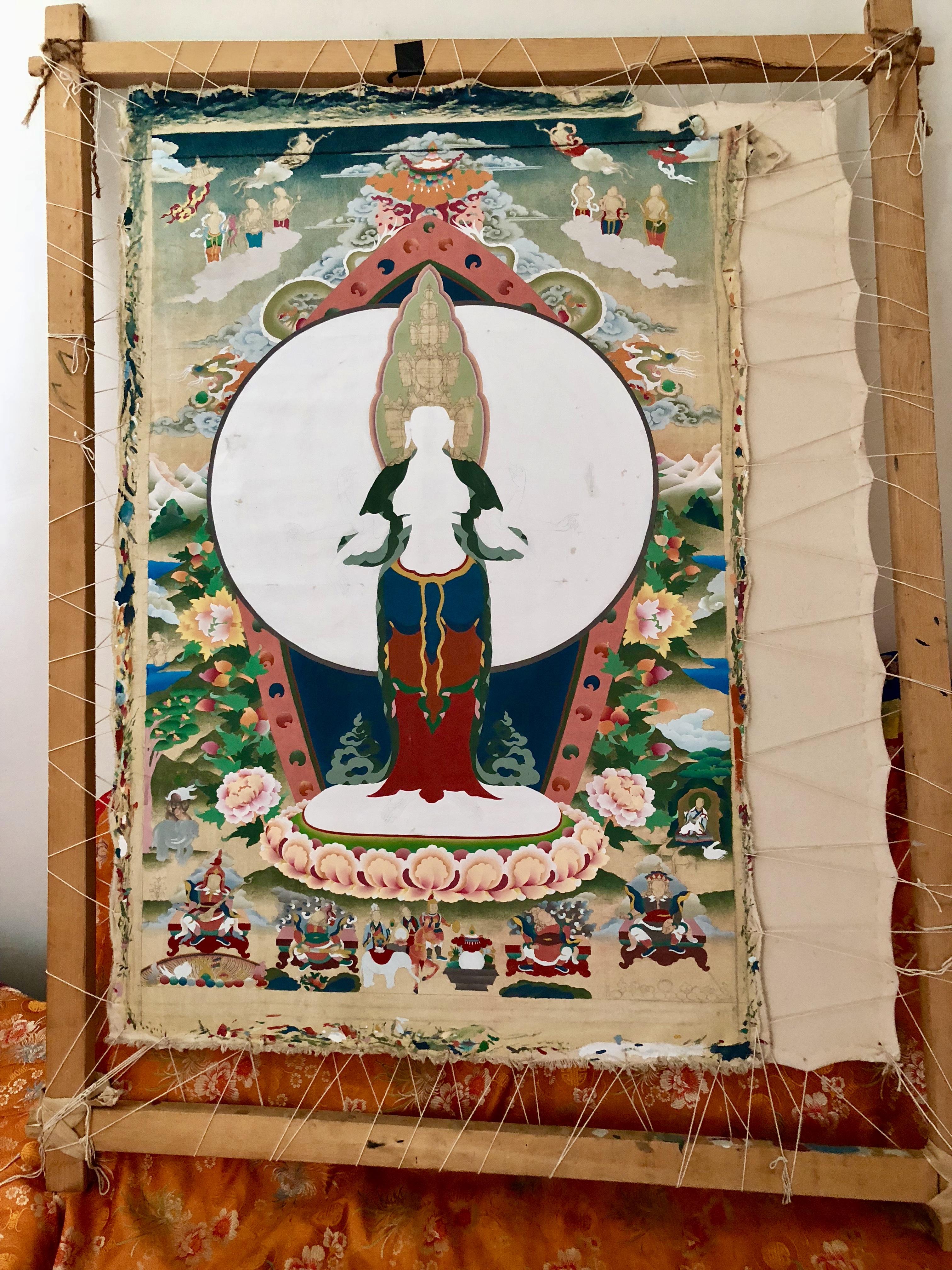
Tinzen’s current thankha project is an image of Avalokiteshvara, a goddess of compassion with 100 arms. His thankas sell from $5,000 to $100,000 USD. Unlike most modern day thankhas, which use cheap acrylic paints, he uses the best traditional paints from powdered stone and other natural sources. Original colors are amazingly rich. For example, red comes from coral. Gold is pure 24k gold. Green and yellow come from plants. Aqua comes from turquoise stone, and blue is from bird poop gathered fom rocks by the rivers.

Tinzen is leading us on a camping tour of some of his favorite monasteries and temples he has painted. That’s him wrapped in red monk’s robe. We’ll visit Bhumtang, a mountainous area in central Bhutan. Then we’ll go to the Phobjikha Valley to the Gangteng Monastery. Tinzen says he’s a camping expert and he’s right! But this is more of an expedition, complete with cook, set-up man, and a separate truck filled with tents and bedding.
Our camping trip begins with a hot picnic lunch on the way at Lampelri Royal Botanical Park. Lama’s sister Tsering Om has packed us a banquet: rice, soup, datshi (peppers with cheese), spicy beef, cucumber slices, deep fried peppers, and butter tea. Dogs patiently await leftovers.
Tinzen drives up the mountain for 2 hours. Our first destination is the Wangdue Phodrang Dzong. Dzong means fortress or monastery.
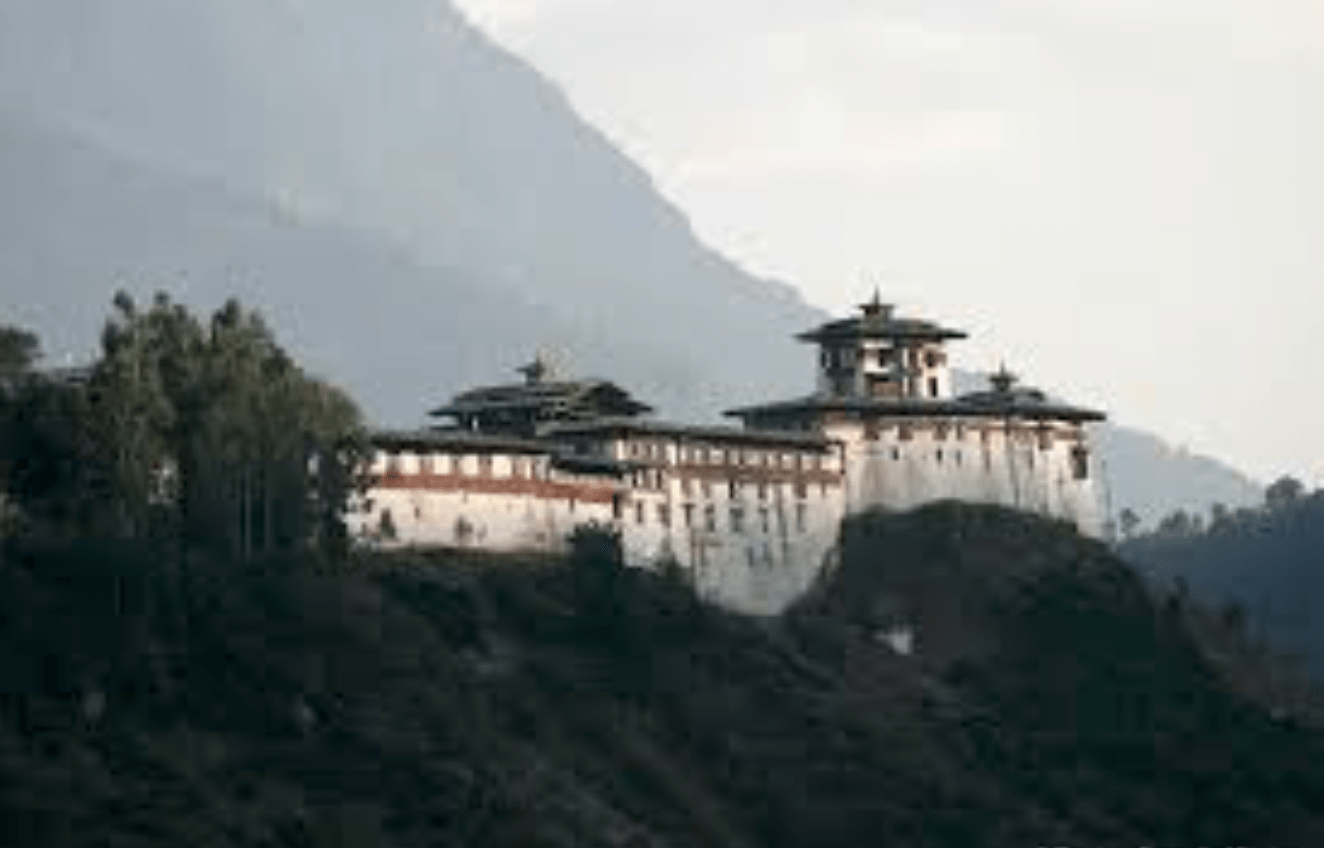
Wangdue Phodrang Dzong was built in 1638 atop a high ridge. The founder, Zhabdrung Ngawang Namgyel, was told by an old cripple that if he built a temple in on a ridge that resembled a sleeping elephant, he would unite the country. Zhabdrung saw that the old man was really Yeshey Goenpo (Mahakala) and sent a scout to study the location. The scout reported that he saw four ravens circling the ridge, which flew away in four different directions when he approached. Taking this to be a good omen, Zhabdrung constructed the dzong in 1638.
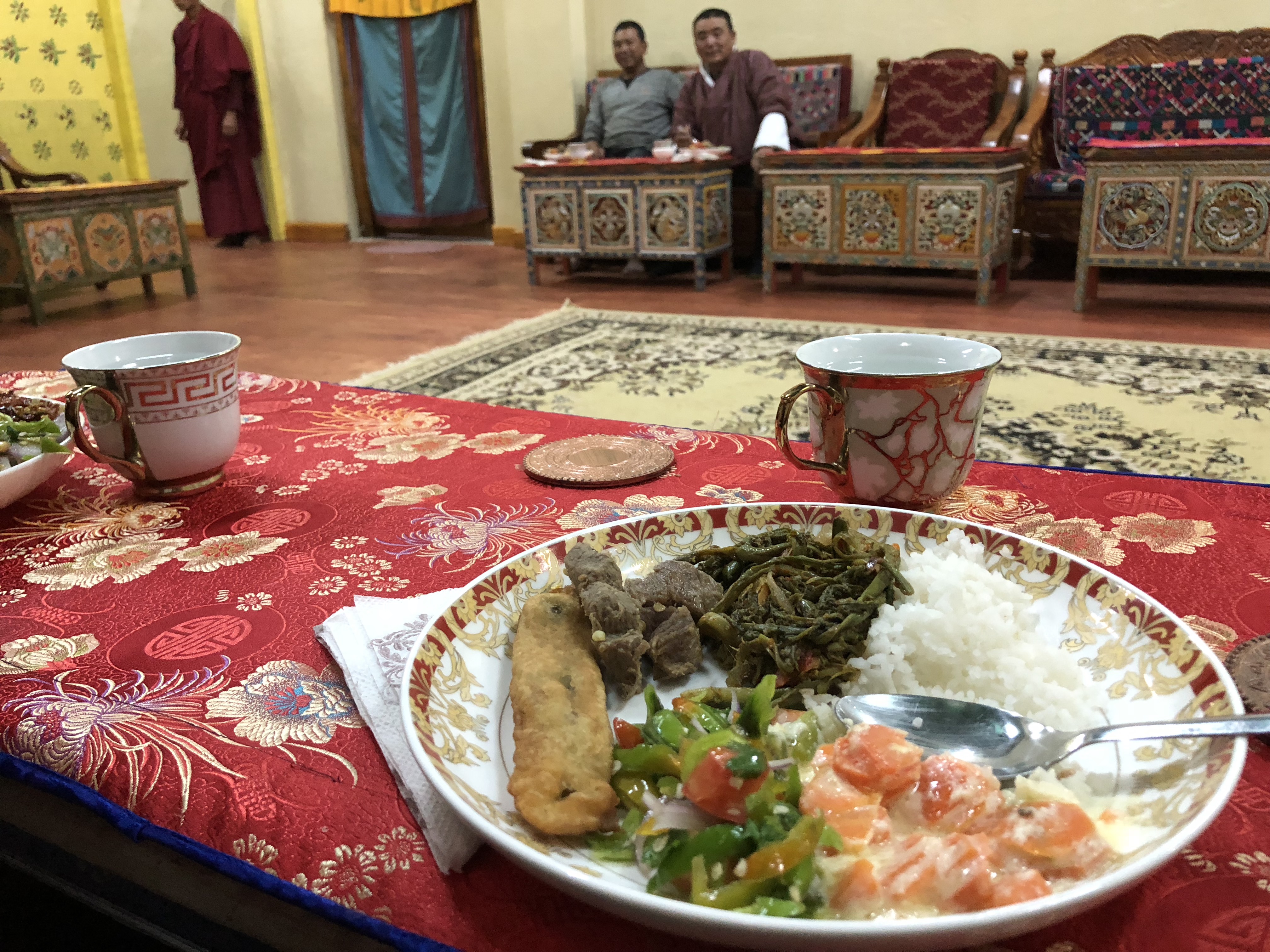
Dinner at Wangdue Phodrang Dzong is simple and delicious. Clockwise: rice, carrots with yak cheese, mixed salad, deep fried peppers, impeccably spiced beef chunks, and wild ferns gathered from the surrounding forest. The conversation was all about upcoming elections this Saturday the 15th. Now we’re off to bed, as tomorrow’s wake-up call is 3:50 am!
Puja at 4:30 am
We are awakened by a monk at 3:50 am, to attend the morning puja. We quickly dress in formal attire and climb interminable steps up to the main hall. I’m so excited I can hardly breathe. My legs ache from so many steps. Monks are waiting for us in a sumptuous hall. Prostrations are very difficult in my newly wrapped kira. I’ve no idea how many prostrations we did – could have been 6 or 60. I was praying to make it on every one. These monks are very fit.
Finally we sat down, the monks started chanting, and I was happy. They chant every morning for the benefit of all sentient beings. Every 30 minutes, tea was served from huge urns. At the end of the 90 minute puja, breakfast of rice and soup was brought in. Photos and videos of the main hall are strictly prohibited, however Lama took these two surreptitious tastes for you.
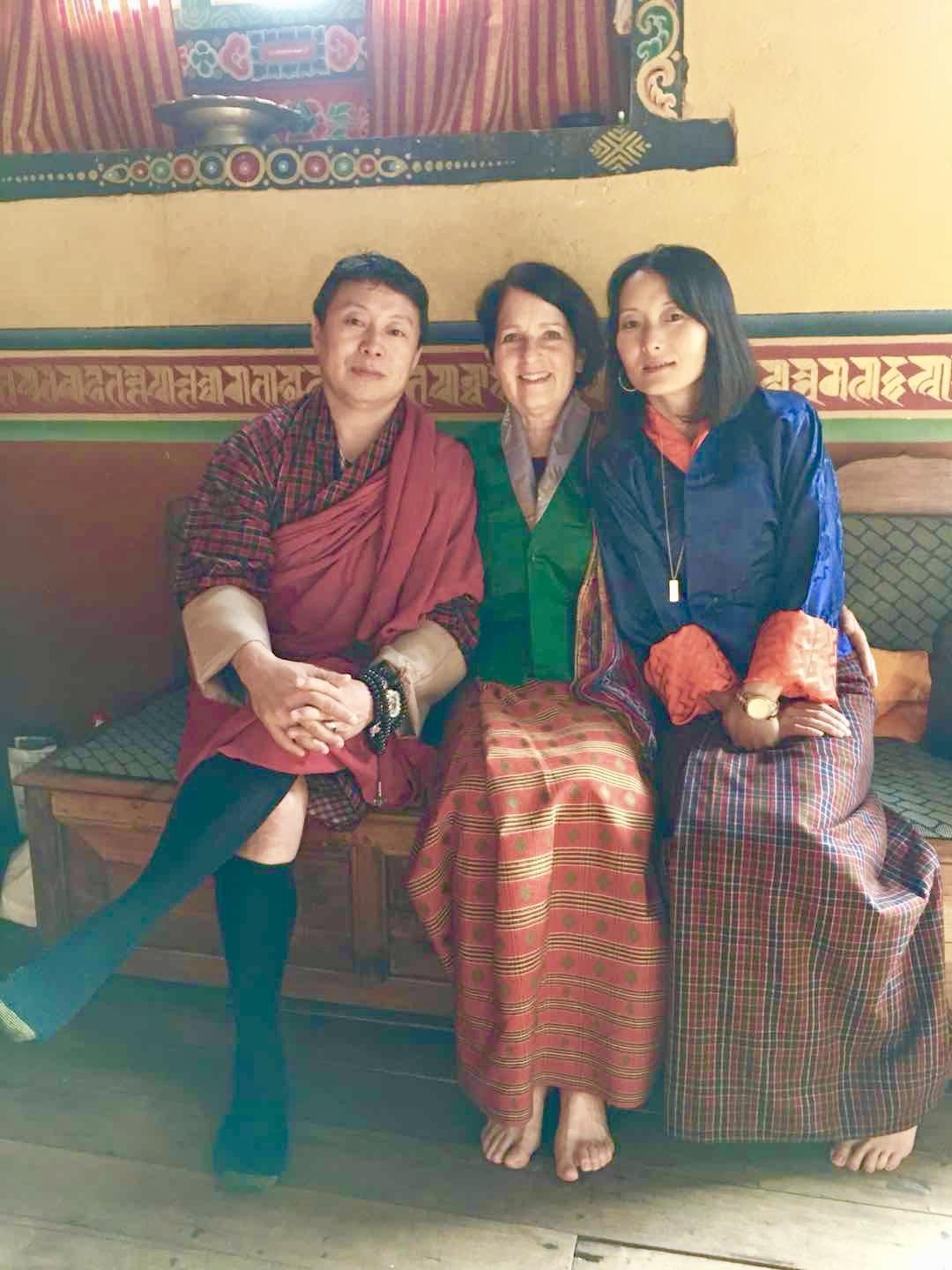
After puja, relaxing with Lama and his sister Ghalem.
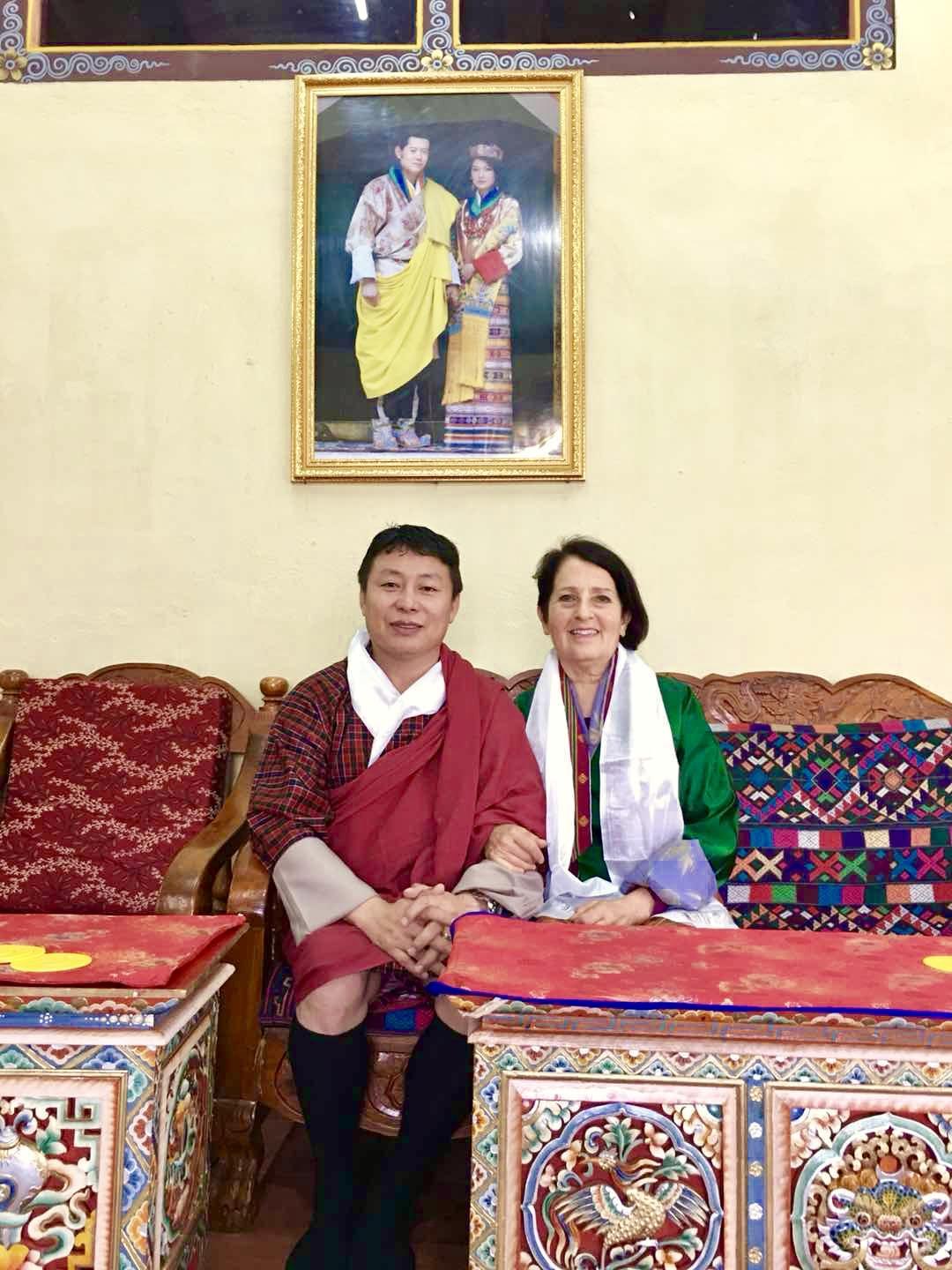
After the puja Lama and I sit in the tea room. Ghalem has loaned me a traditional kira to wear, and Lama showed me how to wrap it. The king’s photo is an altar in every business and public place. I feel happy and safe.

This is a view from our little tent. We’re camping in Bhumthang, a central area of Bhutan. The mountains encircle our camp. Every morning we wake up and Lama begins his chanting. In the blue tarp kitchen, our staff prepares butter tea. Soon we’ll sit on yak hides and have breakfast around the fire.

Tinzen and Ghalem serve a delicious lunch at our riverside campsite. See the traditional suspension bridge over the river? Neighbors walking across are invited to join us for meals and tea. “This is our way”, they explain. The neighbors reciprocate with vegetables and talk of the election. We feel welcome.

Lunch is red rice, red chili peppers with cheese, scrambled eggs with yak cheese, beef jerky potato soup, and butter tea. Yumm!
Tinzen decides we need all the comforts of home. So he and the staff are building a hot stone bath for us by the river! The wooden box is on loan from a local friend. See them making a huge bonfire and putting big river stones into it? The hot stones heat the water. Everybody got a hot bath before bed that night. It was amazing! For another perk, they even dug a camping toilet covered with branches and a tarp for privacy.

Hiking with Sherpas at 10,000 feet?
To get to the next monastery, we drive for an hour up to the top of the mountain. When the road ends, Lama, Tenzin, Ghalem and I start walking up a steep incline on a rudimentary path at 10,000 feet above sea level. After 20 minutes, OMG I’m drenched in sweat. After 30 minutes I sit down and tell them sheepishly I need to rest. Even though I’m quite fit by most standards, AND I’ve been doing Live O2 Exercise Oxygen therapy with my brilliant MD, Dr. Angelique Hart in ABQ, I still can’t keep up with these guys. They’re simply built differently – long torso, powerful lungs, short legs, and thick leg muscles. I just laugh and say: “I can’t keep up with you”. Tenzin kindly makes me a walking stick. He patiently rests with me and says: “You will be strong soon. Eat more red rice and yak cheese”.

We finally arrive after a 2 hour hike up the mountain. It’s a jewel of a monastery. This wonderful monk serves us butter tea. Probably not too many visitors. He shows us two sumptuous shrine rooms adorned with statues from the 8th century. The energy of Padmasambhava is everywhere. There are just a few other monks living here. This monk is quiet and strong. I feel I have come home. I meditate in the sacred rooms and see that I once lived here for seven years as a monk in the 10th century. Finally as we leave down the mountain, he rings the bell smiling, as if to say: “I see you too”. I turn to face him and bow deeply. I feel deliriously happy.

This is an exciting week in Bhutan. Energy is rising before election day Saturday September 15th. My Lama is famous in Bhutan politics, as he was a Parliament member, and is one of the founders of the leading DPT party. Sparks are flying. Please say a prayer for equality, justice, and Gross National Happiness in Bhutan!

To have a legal marriage certificate in Bhutan, it must be approved by both parents or two next of kin. Yep. This applies to me and the Lama. My three sisters are delighted to help, and each emailed me their contracts. I requested that they smile, since these authorities are pretty serious. Heidi also sent a topless version, which, um… sadly, won’t be publicized.
Thanks for tuning in. Friday is the day my travel log comes out. Probably. Don’t know if I’ll have internet next week. See you soon!


